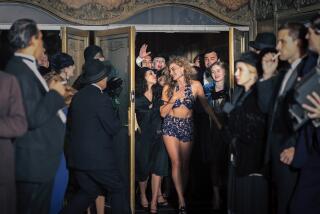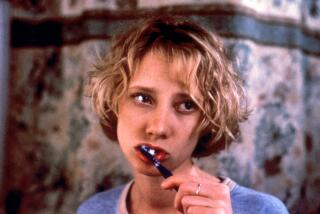Mary Brian, 96; Screen Ingenue Bridged Silent, Early Sound Eras
- Share via
Mary Brian, a romantic leading lady whose memorable career began in the era of silent and early sound films, died of natural causes Monday at a retirement home in Del Mar. She was 96.
Brian, a longtime resident of Studio City, appeared in more than 70 films from 1924 to 1947. She co-starred with such leading men of the era as Gary Cooper, Cary Grant and James Cagney, and at different times during the 1930s was engaged to Grant and Dick Powell.
She played Wendy in the first screen version -- a silent -- of “Peter Pan,” released by Paramount in 1924. She also portrayed Molly Wood opposite Cooper in “The Virginian,” the first major western film with sound, produced in 1929.
In Hollywood, the petite actress with dark brown curls ringing her face was known as “that nice, sweet Mary Brian,” in part because of her solid professionalism.
“As a leading lady, she was reliable, competent -- someone you knew would never give you any trouble on the set,” said Anthony Slide, a film historian and longtime friend, who called Brian one of the greatest ingenues of the silent and early sound era. “She was very natural in life and on screen.”
She was born Louise Dantzler in Corsicana, Texas, in 1906. Raised by her mother, she moved with her family in the early 1920s to Long Beach, where she entered a beauty contest.
She did not win the contest, but caught the attention of Paramount, which was looking for children to cast in director Herbert Brenon’s movie of “Peter Pan,” based on the J.M. Barrie classic about the boy who never wanted to grow up.
She was 18 when she was cast as Wendy, but Paramount executives trimmed two years from her age because they thought 18 sounded too old to play the girl who befriends Peter. After that, Slide recalled, she did not bother to correct it, preferring to tell inquisitive reporters that her age was “negotiable.”
Paramount gave her the stage name Mary Brian and kept her under contract from 1924 to 1932. She was featured in more than 40 films for the studio, playing juvenile leads and co-starring roles in such films as “Beau Geste” and “Brown of Harvard.”
She co-starred with Fredric March and Ina Claire in director George Cukor’s 1930 classic “The Royal Family of Broadway,” and with Adolph Menjou and Pat O’Brien in the first film version of “The Front Page,” directed by Lewis Milestone and released in 1931.
In a recent interview with film historian Leonard Maltin, Brian recalled how she and her fellow actors reacted to the advent of sound in pictures.
Buddy Rogers and Dick Arlen “and our whole little gang, we were all terrified because we kept saying, ‘Your voice doesn’t sound like your voice.’ And they were going to make tests of us.... Luckily, it turned out all right. But we were terrified.”
Some studios, such as MGM, began to give actors elocution lessons. But Paramount “never did,” she told Maltin. “They just put us in there, and you sank or swam.”
During World War II, Brian made three tours of Europe and the Pacific to help entertain U.S. troops. She had a harrowing stint near the front lines at the Battle of the Bulge and toured the Enola Gay after it dropped the atomic bomb on Hiroshima, Japan.
Seeing firsthand the cruelties of battle sapped her enthusiasm for making movies. Brian acted only occasionally after the war, ending her film career with “Dragnet” in 1947, the year she married film editor George Tomasini.
During the 1950s, she worked briefly in television, appearing in the CBS sitcom “Meet Corliss Archer.” But she focused on supporting Tomasini’s career. Tomasini, who was known as Alfred Hitchcock’s favorite editor, died in 1964.
After her husband’s death, Brian devoted herself to painting portraits, which decorated the walls of her Studio City home. Her subjects included many of her Hollywood friends, such as Hitchcock, comedian Red Skelton and gossip columnist Louella Parsons.
More to Read
Only good movies
Get the Indie Focus newsletter, Mark Olsen's weekly guide to the world of cinema.
You may occasionally receive promotional content from the Los Angeles Times.











